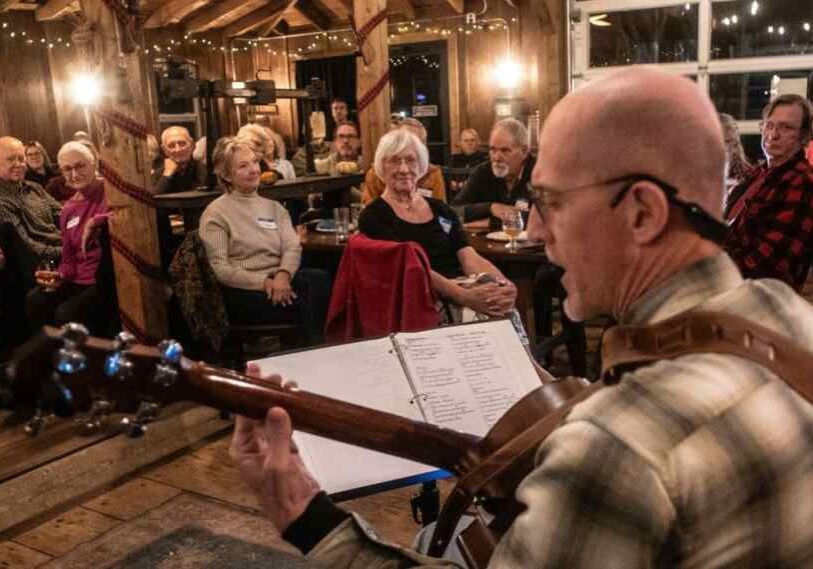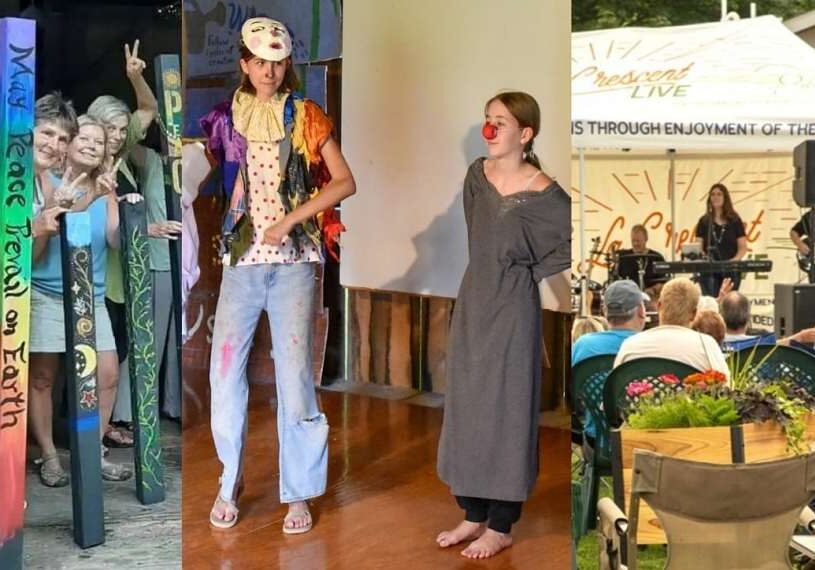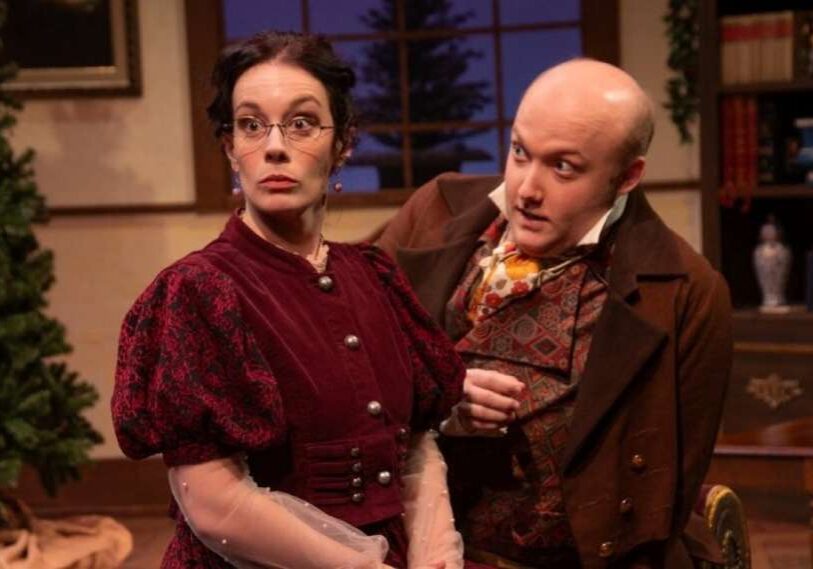Flourish at DreamAcres: 20 Years of Youth, Arts and Agriculture in Rural Minnesota
Mixing soil and stage — how arts and agriculture fed the creative spirit

FILLMORE TOWNSHIP, FILLMORE COUNTY — The crowd watching the Flourish summer camp attendees debut their performances at DreamAcres on Sunday, August 3, 2025, literally found it a moving experience.
Spectators made quite a trek as a staff member holding a long pole with a Flourish banner on top led them to each performance. More than ten original performances were spread through the grounds of DreamAcres, an off-the-grid, organic farm located between Spring Valley and Wykoff.
The audience first gathered in a clearing behind an A-frame building, some seated in folding chairs set up in the grass and the more adventurous ones finding a seat on an old piece of agricultural equipment, heeding the warning of Flourish founder and co-director Eva Barr to watch out for rust, while others stood.
They watched a performance by two youth — Liliana Hood and Mari Kottke — acting as daughter and father who are tent camping. This performance explored issues such as how technology is taking away from being present in life with the unexpected twist that the adult, not the youth, is chained to his cell phone.
From there, the crowd walked to the other side of the building to watch dancers perform on the gravel driveway. After moving to another clearing to take in a solo performance by Anawynn Haug about fitting in with peers, people followed the Flourish banner to the front of a building with a giant robot, who would appear in two more pieces in other locations around the farm.
The only indoor setting was in the barn, where people watched two performances and danced on a wooden floor before going back outside to continue the journey that included performances in locations ranging from farm buildings to a large clearing and field in the valley to a creek in the woods
These public performances were the culmination of a week of preparation at Flourish, a summer camp that mingles arts and agriculture, which wrapped up 20 years — and its final season — with this show.

Malia Burkhart, a multi-disciplinary artist, shows campers at Flourish some tips on painting masks during a weekday session that prepares students for creating their own original performances in front of the public. (Photo by David Phillips)
Prior to the public performances on Sunday, artists mentored young people in the disciplines of theatre, puppetry, dance, music and voice for one week in the context of a farm so they could express their unique ideas.
Final Flourish
It has been a really good program, accomplishing much over the 20 years, said Barr, but she feels that it is time for her to step down; her ability to see this high-energy camp through has worn on her over the years as she is the point person for all the details and has many day-to-day responsibilities, such as cooking lunch and taking care of various practical needs of the camp.
Besides, she thought the 20th anniversary seemed like a good time to end.
“So it’s a camp about flourishing, right? One would say, okay, so if there’s an end, what does that mean?” Barr mused. “And I think it means that it has blossomed and borne fruit, and now it’s time to hit the compost pile.”
However, what she didn’t say is that compost is eventually used to generate new growth, which means, she later revealed, that the camp may continue to flourish in some other form.
“It could become something else, and there are plenty who’ve been involved who would like to see something else go on, but Flourish as it has been conceived and rendered by me, this is it,” Barr explained.

A giant robot made three appearances during the public performances Sunday, Aug. 3. Mari Kottke, Adele Stacken and Wesley Smith performed as the robot at different times while Max Moon was always battling on the ground. This shows the final performance, conceived by the design team, called “Project Operation World Domination,” although it turned out the powerful robot had a chicken for brains. (Photo by David Phillips)
Roots planted in 2003
It’s been quite a journey for Barr, who co-founded Lookingglass Theatre Company of Chicago after graduating from Northwestern University in 1988. A native of Albert Lea, she took some time off to learn something of the world through further study, travel and experience of farms and families in Central America, Europe and Africa before coming back to Minnesota in 1995 to establish DreamAcres with her partner, Todd Juzwiak.
“I had my own personal history with having spent a short period of my summer at summer camp and finding part of myself at summer camp that I could bring that I felt I couldn’t show in other parts of my life,” said Barr.
“And so when we moved here I knew that I wanted to develop some kind of summer camp that brought together my talents that relied on things that I felt pretty confident teaching,” she said, “one of which was performance and a variety of approaches to performance since I come from theater and acting and dance.”
She also wanted to integrate growing food and eating optimally from what is produced on the farm, “so I called the camp a mingling of arts and agriculture.” She sees performance work as fuel for the spirit, and vegetables as food for the body, both essential.
The camp, started in 2003, is administered by the Dreamery Rural Arts Initiative, a nonprofit organization with a mission “to awaken, harness and exercise a creative spirit that re-discovers itself in the open, fertile spaces on the farm.”
In addition, Barr added, the aim of the program is “to reflect on responsibility as a person in the world.”

Suzette Gilreath, middle, the newest member of the Flourish staff who has been with the program for three years, instructs youth on their dance moves in the barn. (Photo by David Phillips)
Originally, the camp drew a varied mix of campers ages 12 to 17 that included several refugees and immigrants. Now, the campers are ages 11 to 15, which is a more manageable span of maturities that gets youth involved before they take on summer jobs as older teens.
The camp still aims to bring together youth from a variety of walks of life. Most campers are from the four-state region, but some from as far away as the East Coast, California and Italy have attended Flourish.
Intimate, family-like setting for campers and staff
The number of campers is purposely kept limited — up to 18 with 13 attending this year — to make it affordable and more personal.
“Our farm is a unique place and has very unique systems that you just don’t come with an intuitive understanding for, and given that it’s a decidedly small camp about intimate relationships, every camper has a mentor and they spend one-on-one time with their mentors, they spend time in small groups, and they spend time within the whole,” said Barr.
The small program also means Barr and instructors have various jobs, including some of the cooking, while campers help with cleaning dishes and some other chores.
The small scale gives the camp the feeling of family since instructors usually stay on for long periods and many campers come back multiple years and some return later as adults to help out.

Stan Juzwiak, left, who grew up on the DreamAcres farm and now helps out with Flourish, discusses plans with Nikhill Barr Saxena, who attended Flourish and now works with campers developing instrumental and musical skills, in front of the barn where several practices and performances took place. (Photo by David Phillips)
There is also actual family involved in the program. Barr’s son, Stan, who was just 3 years old when Flourish started, was always involved when he was growing up on the farm. He studied improv at The Second City in Chicago and now coaches and performs with improv teams in Minneapolis, but he was still back with Flourish to help out this year.
The longest tenured staff member is Dustin Haug, who once taught dance at Flourish, but loves to cook and now helps in the design of the summer program.
Haug was teaching dance at the Zenon Dance School in Minneapolis when he connected with Barr, starting in 2009 with Flourish. It works out well for him since he teaches science at St. Paul Conservatory for Performing Artists in St. Paul and has summers off.
“I’m an outdoorsy person so I like sleeping in a tent for a week, I like teaching dance class in a barn and, you know, cooking in an outdoor kitchen is, like, totally my wheelhouse,” he said.
He has also drawn his family into Flourish as his wife, Kelly Jo, who studied music at Luther College in Decorah, is now on staff at Flourish and the couple’s daughter, Anawyn, attended camp this summer.

Anawyn Haug continues her performance, “Think about it,” in a creek on the DreamAcres grounds. Hers was among the pieces that were more introspective. (Photo by David Phillips)
Growth over the years
Over the 20 years, the camp has evolved. For one thing, it has become more self-sufficient. In the farm’s early stages, food was prepared offsite, and, for a short span, participants slept at another camp nearby.
As far as programming, one marked change came about 10 years ago when instructors felt there were campers who “we thought could be pushed to another level of action and interaction,” so they developed the design team, said Barr.
“What the design team does is they begin to think more meta about the pieces,” explained Barr. “And so they’re looking at what are the design elements that are speaking to the experience, and how can we provoke more or deepen the inquiry that is wanting to be waged.”
The design team, made up of 14- and 15-year-old campers under the direction of Elliot Saxena, spends the first three days of camp creating something that will be part of the final performance and then shifts to supporting the other campers by sitting down with them and asking questions about their intentions and interests.
The team not only honors young people’s ideas but makes sure everyone authors a piece that is ideally about three to five minutes long to debut on Sunday in front of the public that shows up for the performances at the culmination of the camp, explained Barr.
Camp structured, but youth free to explore themes
Although the camp can appear to be chaotic, it is actually highly structured for the energetic youth with an old-fashioned chalkboard listing each day’s activities. The schedule isn’t all about the arts as it includes a designated time for gardening when the campers either weed the beds or harvest produce to be used for the meals.

Campers also spend short periods taking care of the large garden at DreamAcres. Flourish founder Eva Barr instructs the youth on the activity. (Photo by David Phillips)
The results of the week-long sessions are not exclusively performance-based as Barr noted that they have done visual installations in the woods and different buildings because “we’re really inviting kids to choose a medium that speaks to their skills and interests.”
The finished pieces debuting on Sunday not only have variety in the spaces where they are performed, but also have variety in content, some of which can be quite personal.
“There’s a lot of soul-searching, self-definition, ‘who am I in my peer group’ questions that come up that they work through in their performance pieces,” said Barr.
During the 90-minute event, the crowd watched youth perform pieces that reflected on their identity, humorous performances on a fraudulent fortune teller or advice talk show, musical pieces such as “Flute in the Forest,” a dance called “Blood on My Hands,” an advocacy piece on protecting the prairie and dramatic action involving elaborate puppet costumes such as a giant robot or Frankenstein’s creation.
The finale, called “Project Operation World Domination,” was the last of three acts involving the robot, played at various times by Mari Kottke, Adele Stacken and Wesley Smith, battling with his nemesis, Max Moon.
The final battle, when the robot fell, revealed a live chicken exiting the boxy, metallic head, showing that the robot actually had a chicken for brains, drawing laughter from the crowd.
Flourish has staying power
The unusual mingling of arts and agriculture all seems to work as campers and staff are always eager to return.
Haug mentioned that even though he is only at DreamAcres for a week outside of an occasional visit for the Pizza on the Farm event held Fridays during the summer, “it’s something that we think about for the other 51 weeks of the year.
“It’s like, oh, what are we going to do for Flourish this year?,” he said. “And so it’s just like, it’s this thing that keeps on ruminating, even when we’re not here.”

In an added piece at the end of Sunday’s performances, small groups of campers and instructors emerge from behind each of the eight letters of Flourish to come together for what Barr said was a “final flourish” while the crowd watched from on top of the hill. (Photo by David Phillips)
A few campers who were questioned just before leaving the performance also emphasized their enduring connection to the camp.
Lucy Kottke, who performed as Dr. Chad in an advice/talk show and has attended the camp three years now, said, “I love this camp so much because it feels like a second home to me. I love the people here. They’re so kind and accepting.”
Hazel Moon, who performed as a fraudulent fortune teller, echoed the love for the camp: “The people are amazing, everything’s amazing.”
Norah Lawrence, who chose music as her performance, playing the flute in an opening in the woods, said, “It’s just, like, magical here. One week here, and you feel like it’s a second family, and everybody’s so nice and you’re free to be as weird as you can be and it’s just wonderful.
“I’m sad to be leaving,” she added, “but luckily we’ll be able to come back next year,”
Of course, being able to return is far from guaranteed since Barr is definite that Flourish, as she conceived it, won’t be coming back. However…
When asked about the comment by Lawrence, Barr acknowledged that by the end of the 2025 Flourish there were rumblings about the possibility of the camp taking on a new shape — as in “Shifting Shape,” which, perhaps not coincidentally, was the theme printed on the program for this year’s public performances.
Related stories from Root River Current: Root River Current’s coverage of the arts is made possible, in part, by the voters of Minnesota through a grant from the Southeastern Minnesota Arts Council thanks to a legislative appropriation from the arts & cultural heritage fund.






